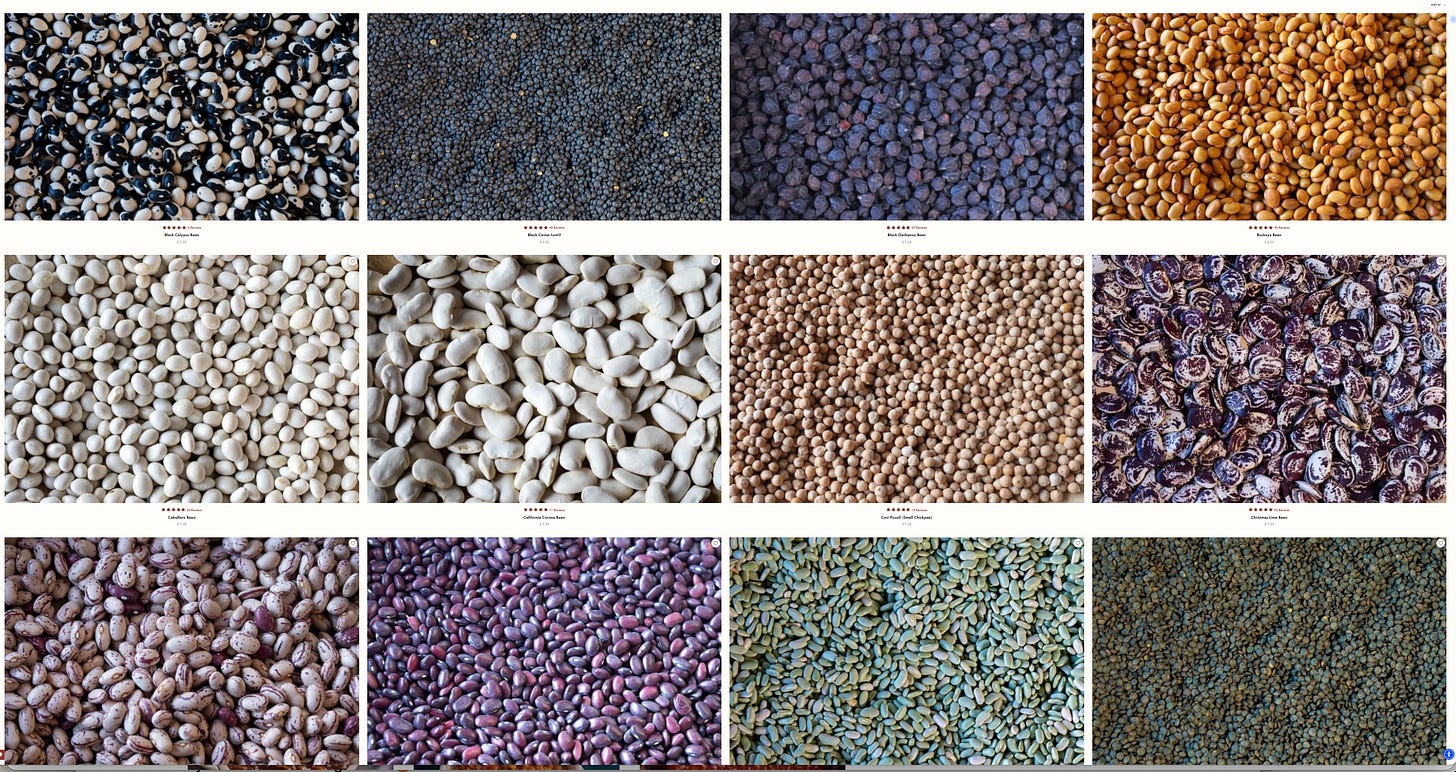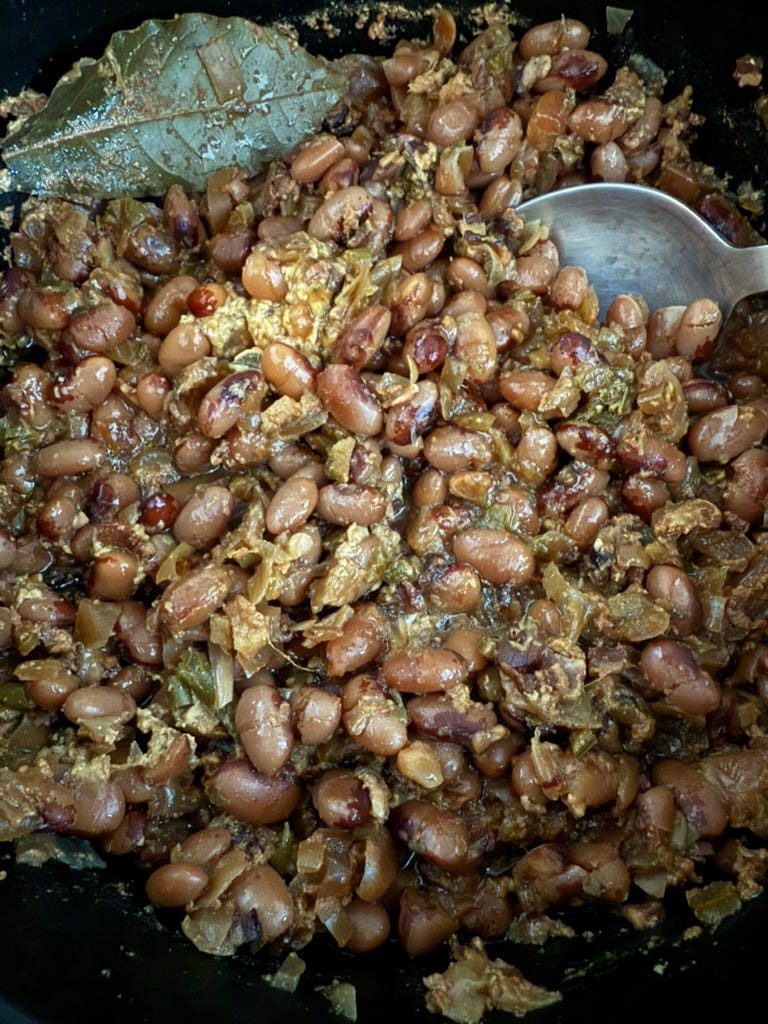It’s summer. I’m in New England. Baked beans have been a staple in these parts since the 17th century. I almost forgot about them, to be honest. Because Nate is not a bean lover, I usually just cook up small batches of beans to eat with my lunch during the week, while he’s out of the house. A big pot of baked beans is too much for me to handle alone. Or so I thought.
To go with our traditional 4th of July meal of hamburgers, hot dogs, potato salad, and coleslaw, our hosts in Maine last weekend made a batch of Boston baked beans from the recipe I wrote in my Kitchen Sense cookbook. I had forgotten how delicious they were. In fact, I probably could eat a whole pot myself.
There are a couple of things that make my recipe for Boston-style baked beans so good. The first is that the beans are not overly sweet. Although I have no concrete proof, I suspect baked beans have gotten sweeter over time, as our predilection for sugar has increased and the price of sugar has decreased. Some baked beans these days are like candy; I find them overly cloying. Boston baked beans are distinct for the molasses used to make them—added in the mid-18th century—which contributes a particular sultry flavor. But I have found any dark sweetener, such as sorghum molasses, silan (date syrup), dark amber maple syrup, dark brown sugar, strong honey, or even hoisin work great, too.
It’s also cool that you make these beans simply by throwing everything in a covered baking dish at night before you go to bed and setting them in a low oven to bake while you sleep. When you wake up in the morning, your home is perfumed with baked beans. (I realize this aroma may not be totally appealing to some, but to me it is heaven, and it’s better than many scented candles you can buy.)
I wonder if this overnight technique—perhaps a bean pot placed in the smoldering coals of a wood-burning stove—is what lead to the British breakfast tradition of beans on toast. I’d be lying if I said I didn’t always sneak a spoonful of baked beans when they were ready in the morning. To serve later, you simply reheat them on a low burner or pop them back in the oven. (Watch closely so they don’t burn.)
If you prefer to perfume your house later in the day, you can, of course, assemble and bake the beans in the morning and let them cook throughout the day. They’ll be ready for dinner if they are in the oven by 10 am.
The type of dried beans you use can vary. Traditional would white navy, soldier, or Great Northern beans, but you can also use cannellini, or just about any smallish bean, whether white or not. Rancho Gordo has an incredible selection. I’d bake any of their beans.
A word about the meat. Proving yet again that everything is better with it, bacon has become a common flavoring of baked beans, though they would traditionally have been made with salt pork. Both produce delicious results. Country bacon or guanciale, which are generally cured but not smoked, are ideal. If you are someone who orders baked beans with barbecue, you are likely and fortunate to have had them made with the burnt ends of smoked brisket. I’ve made baked beans with smoked brisket, pastrami, and even bits of corned beef, all good. Use duck confit and you are on your way to cassoulet. (For vegetarian baked beans, omit the meat altogther, duh!, use vegetable stock instead of water, and stir in 2 tablespoons of red or white miso.)
Many recipes for baked beans suggest you soak them before their long, slow cooking. This seems counterintuitive to me, as the long cooking alleviates any benefit of time gained by soaking. There is some evidence to suggest that soaking beans and discarding the soaking water helps remove some of the complex sugars, i.e., oligosaccharides, that cause flatulence. But I’ve read several food-science papers that show that not only are the sugars removed this way negligible, long, slow cooking does more to break down the sugars than soaking does. I don’t soak my beans for baked beans and I don’t find myself farting any more or less than when I eat beans cooked other ways. After this weekend, maybe Nate has a different opinion. You’ll have to ask him yourself.
Finally, why beans? Well, beans are a great, affordable source of protein that are good for you and good for the planet—they help repair degraded soil by fixing nitrogen. That’s why I’ve been involved for years in the U.N. endorsed Beans is How campaign to double global consumption of beans and legumes by 2028. Baked beans may very well be a gateway bean for those who think they don’t love them. If only I could get Nate to give them a try…
RECIPE: Baked Beans
Makes about 2 quarts, enough for 6 to 8 servings
2 cups (about 1 pound) dried beans, such as navy beans, soldier beans, Great Northern beans, cannellini beans, or others, rinsed in cold water
6 ounces salt pork, country bacon, slab bacon, smoked brisket, or other flavorful, fatty meat, diced
1 large white or yellow onion, finely chopped
2 cloves garlic, minced
2 tablespoons blackstrap (unsulphured) molasses, sorghum molasses, dark honey, dark brown sugar, or hoisin sauce, or 1/4 cup dark amber maple syrup, silan (date syrup), or a combination of any of these
2 tablespoons Dijon mustard or 1 teaspoon dry mustard
1 small ripe fresh or canned tomato, finely chopped, or 1 tablespoon tomato paste, or 2 tablespoons ketchup
1 tablespoon minced fresh ginger or 1/4 teaspoon ground ginger
2 bay leaves
Pinch of cayenne pepper or a couple of drops of hot sauce, such as Tabasco
1 1/2 teaspoons kosher salt
1/4 teaspoon freshly ground black pepper
In a large (5-quart) Dutch oven or other ovenproof pot with a heavy lid, combine the beans, pork or other meat, onion, garlic, molasses or other sweetener, mustard, tomato, ginger, bay leaves, cayenne, salt, and black pepper. Stir in 4 1/2 cups of cold water. Cover the pot, set in the oven, and turn the dial to 250°F. Go to bed. After about 7 hours, check the beans; they should have swollen and softened, absorbing most of the cooking liquid. The top will look dry, but if you stir up the beans, you’ll see the liquid below the surface. If the beans aren’t quite tender, keep them going for another hour or so. (If you want to make them in the morning for dinner, get them in the oven by 10 am.)
When done, remove the beans from the oven and let them sit covered at room temperature until cool. They will absorb any excess liquid. Stir gently so you don’t break up the beans. Baked beans can be served at room temperature or warm. To reheat, set covered over a low flame or place back in a 250°F. oven. The beans have a tendency to burn, so watch them carefully, stirring from time to time. You may need to add a little water to prevent the bottom from scorching.
For a vegetarian variation, omit the meat, use vegetable stock instead of water, and add 2 tablespoons red or white miso to the pot before baking.







Mitchell, congratulations, although as a Canadian you must have baked beans deeply grounded in your heritage too. I love Rancho Gordo beans (name me a cook who does not!) but for Maine baked beans I do prefer our local yellow-eye or soldier beans or even Jacob's cattle beans with their mottled surface. Trivia question for the day: I once thought the beans were called Jacob's cattle because they were originally intended to feed the farmer's herd, but no--they are called that because they are speckled and spotted, just like Jacob's cattle in the Bible. You could look it up!
My housemate recently bought the Rancho Gordo cookbook and I was reading it's recipes for cassoulet last night which inspired me to decide to make it for Christmas this year.